Letter from Mr. Petrie in reply, or by way of comment on Mr. O'Donovan's letter dated Loughrea October the 23d 1838 -
[Hand of G. Petrie:]
October 25th 1838.
My dear John,
You know that I always read your letters with great pleasure, and with the expectation, rarely disappointed of receiving instruction as well as amusement.
You may imagine then with what peculiar interest I read your last, in which you give a learned dissertation upon the characteristics of Irish architecture, a subject which has occupied my especial attention for some 30 or 40 years, and which I feel that I am not after all, perfectly skilled in yet. O'D. thought I, who knows all my opinions on this subject, all that I have considered as certain and proved, and all that remains doubtful and unproved, is going to enlighten me as usual, and henceforth there will be nothing uncertain, nothing in short to be done.*
I must however confess that though I may have been as usual highly gratified at your ingenuity, and amused at this confidence of your conclusions, I am by no means
*[In the margin to the left of this paragraph is an insertion that appears to have been intentionally erased:] Not so long altogether: A month in each year for 40 years amounts]?] to 3 years and a bit [only?] It is not philosophical to get out of temper!, JO'D. [This insertion was erased after the letters had been bound, as fragments of it remain untouched at the extreme left-hand edge of the page.]
satisfied that these conclusions are always right. I mean particularly those which are new, for there are several which are undoubtedly true, but these are not new, at least they are not new to me nor to anyone who has ever heard me converse on the subject.
As I may perhaps claim some authority to give opinions on this subject, I shall make a few comments on your several conclusions in the order in which they occur, pointing out what is true but not new and what is new but not true, i.e., not proved to be so. And, as the search after, and establishment of truth has been always, is and ever shall be, our only object, you will I have no doubt receive these opinions however different from your own, in the same spirit of good humour and candour in which they are offered. [In left-hand margin: You have asserted a good deal, but you have only opposed assertion to assertion! Subjudice lis est. I still stoutly deny the antiquity of the pointed arch in Ireland. JO'D}
Your first conclusion is that respecting the want of early antiquity of the church of Killcluana, or in other words, that it is not the original church erected
by St. Grellan to whom it was dedicated. That this church is not of the 6th century I feel quite certain; but without a more definite description of "the Gothic doorway" - by which I understand a doorway of the 12th or 13th century, and a certainty as to the age in which St. Grellan flourished, I should pause before I concurred in your conclusion. But this is a question of little consequence - your general "characteristics of the primitive Irish churches", which follow, are more worthy of consideration.
1. You say that "they are always of small dimensions, seldom exceeding 15 ft in breadth or 36 in length." [In left-hand margin, hand of J. O'Donovan: They are 60 feet by 21 very frequently] On this I have to remark that they are not always, though they are certainly generally of small size. You will soon see an example of a large church of considerable size and of the primitive ages - I mean the great church of Killmacduach; for though this church has been greatly enlarged in the 13 or 14 century, enough of the original structure remains to show that it was properly a Temple mor or a Damliag. Look at it carefully. I could point you out many other examples, as the Cathedral church of St. Kevin at Glandalough which you will soon see &c but
one is sufficient to destroy your rule. What say you to the measurements of St Patrick's church at Ardmach as given in the tripartite and which was the model given by an angel for the Damliags of Ireland? Was it not 60 feet?
2. "They are invariably built of large stones &c." They are almost invariably so, yet I have seen some churches as well as round towers not built of large stones which I could not help considering as of the primitive ages of the church in Ireland as for instance the church of Rath Michael, Co. of Dublin, the Round Tower of Kildare &c. We have, you know the evidence of Giraldus that the latter was in existence in St. Brigid's time, and I have no doubt of its being the original tower belonging to the church described by Cogitosus as having three doorways.
3. They contain but one doorway, which is invariably placed in the middle of the West gable, measuring from 5 [feet] 6 [inches] to 6 [feet] 6 [inches] in height, and being always narrower at the top than at the bottom &c. This is also true generally but not invariably - see the remark above relative to the church of Kildare. The great church at Glandalough has two original doorways remaining and had perhaps a third. [In left-hand margin, hand of J. O'Donovan: Some very few churches may have contained two doorways, but that should be made an exception; mine is the general and correct rule; How many exceptions should destroy a general rule?] St. Caomhan's church in one of the Arran Islands, has two doorways, both, if I recollect
rightly, original. And though the ancient doorways generally have inclined sides, like the supposed Egyptian, yet there are many examples in which the sides are upright as in the very ancient doorway of Kilcrony in the County of Wicklow which is truly cyclopean. [In left-hand margin: Cave! JO'D] I should also observe that I have seen some doorways of the earliest antiquity, more than 7 feet in height, as the doorway of Aghawall, under Croagh Patrick which is a noble specimen of its class - Here it is.
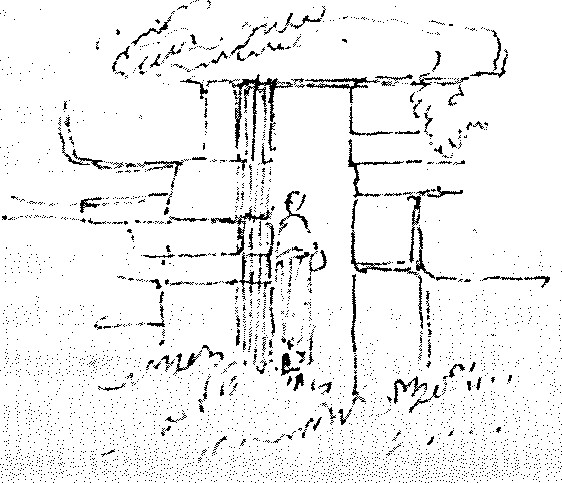
(Look at this again. Produce another and prove the antiquity of this from history. J.O'D.)
Will you say this is not of the primitive ages? and yet its sides are not inclined. Kilcrony is similar but somewhat smaller.
4. "The south wall never contains a doorway, but generally one window, sometimes in the round lancet (narrow) style & some times in the rectilineally pointed style." To the universality of this rule I also object. I have seen many churches of the primitive ages which have doorways
in the South wall, and you will see some of those before long. Look at the church of Temple Muire at Kill Mac Duach. [In left-hand margin: This church is very modern JO'D] The Cathedral church at Glendalough has an original doorway in the South wall enclosing a Sacristy. And the very beautiful oratory at the same place, called the Priest's house has its doorway in the South wall. So have several of the churches in the Arran Islands, as Tiglach Enda, which is unquestionably of the 6th Century. [In left-hand margin: It was all rebuilt except the east gable JO'D] Temple Brican, in like manner has its doorway in the South wall, and it is pointed, though the whole church is so ancient in its character of masonwork that Coll. Pratt would swear it was Roman work, and indeed I have little doubt but he is right. [In left-hand margin: He is wrong as sure as I exist JO'D] Necessity often required a departure from the general rule in this respect, as when the church was in a very exposed situation. Thus I find in one of my note books the following notice of the church of Killespug brone in Cuil Irra - written on the spot.
It is a rude and inelegant building, evidently
of the 5th century. The Doorway is in the Roman style and, contrary to the usual mode, placed in the South wall, - a deviation from custom rendered necessary from the exposure of the building to the blasts from the sea on the west side. The windows - two in number are in the East and South sides. That in the East, has a semicircular head; the other is quadrangular.
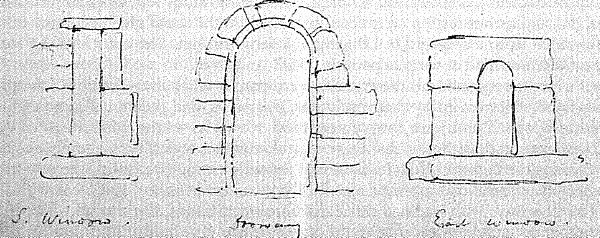
Another example of a deviation of this kind is found in the church of Ath hanna or Ath-Moinna in the same county in which the doorway is placed in the North side in consequence of the approach to the church being on that side. This doorway is also in the Roman style and hence perhaps you will object that it is not
primitive; well be it so. But (what) would you call this doorway of the church on Church-island in Lough Key?
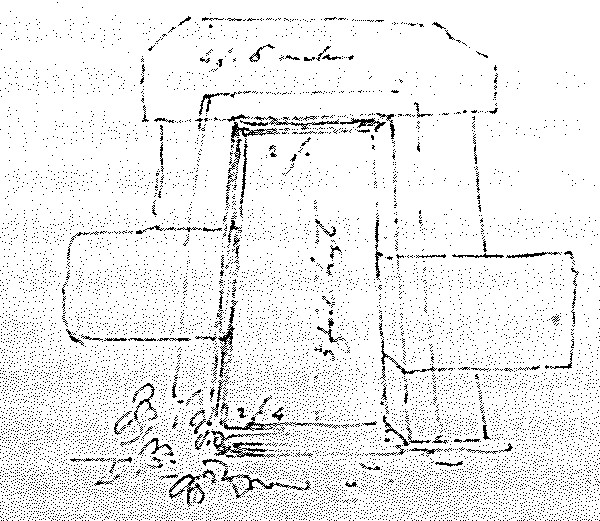
If this doorway be not of the 6th century, I never saw one that was, and yet this is in the South wall! This Church also, like the great church at Kill-mac-duach, contradicts your assertion as to the size of the primitive churches for it is 21 feet wide. I shall say nothing about its length, which is 90 feet, as it appears to have been encreased in the 11th century.
Your next general assertion is that every doorway and window in the ancient style are[?] at top rectangular, perfectly semicircular or rectilineally pointed and this leads to your 5th conclusion, that, "It must be received as an unquestionable fact that the curvilineal form of doorway or window
is not to be found in any church older than the year 1126." You mean, of course, the curvilineal pointed form; but where is your proof of the truth of this sweeping conclusion? for I should like much to see it, as it would remove a great deal of uncertainty as to the ages of very many churches in the country. You will answer I suppose that you have proofs derived from observations. But will this assertion be enough to prove that all the churches in which pointed windows are found, though in all other respects perfectly primitive in their style, are necessarily of the 12th century? The origin of the pointed arch in the 12th century is the old theory of nearly all the architectural antiquarians of great Britain. It may be true as far as the British islands are concerned, but I confess, that I am not yet satisfied that it is so. If the pointed arch was known and used in Architecture in Rome, in Egypt, and still more the Holy land, centuries before this era, I cannot understand why it should not have found its way into Ireland, either through the foreigners who
immigrated to our hospitable shores, or through the Pilgrims who left them to visit the sacred places; And that pointed arches of very good christian antiquity, if not pagan, are found in all those districts, is now not to be denied. What say you to the church of the Holy Sepulcher of Jerusalem which is composed of pointed arches resting on grecian columns? And I could give you many other instances even more decided as to antiquity [In left-hand margin: I deny the fact. The church of the Holy Sepulchre was rebuilt and remodelled at various periods JO'D]
I remember well when my opinions on these points were exactly what yours are now. I thought the primitive churches were well marked by their cyclopean doorways, and their small semicircular and triangular headed windows. But I have long entertained doubts as to the correctness of this conclusion, and I incline now to the opinion that there are two distinct styles, both equally ancient or at least nearly so; the one the Pelasgic[?] style, as it may properly enough be called, the other the Roman. The first was peculiar to the country, that which
was used in the Cahirs, but with the addition of cement. The doorways with inclined sides and horizontal lintels, the windows also with inclined sides and round or angular heads, and the stone work very large. The second with semicircular arched doorways, lancet headed windows, high and narrow, and the stone work not so large. This style I suppose to have been brought in with christianity, and in many cases blended with it. This latter style I think continued in use with more or less decoration in the doorways, windows and choir arches, till it was supplanted by the pointed or Gothic style, and hence it is often a matter of difficulty to determine exactly the ages of buildings in which it is found. But if we have an age assigned to such buildings historically, I think we should pause before we jump to the conclusion that they are re-edifications or re-erections. As an example of this Roman or imported style, I would point to the beautiful church called Temple Brecan in the great island of Arran, a building which I cannot by any effort
bring myself to suppose of a subsequent date to the ages of the Saint whose name it bears. I[ts] choir-arch is so perfectly Roman in its style of workmanship that any architectural antiquary who should see it would conclude that it was actually the work of Roman hands. Yet the great East window which is evidently coeval with the rest of the building has a pointed arched head. Here is its outline rudely but accurately enough given.
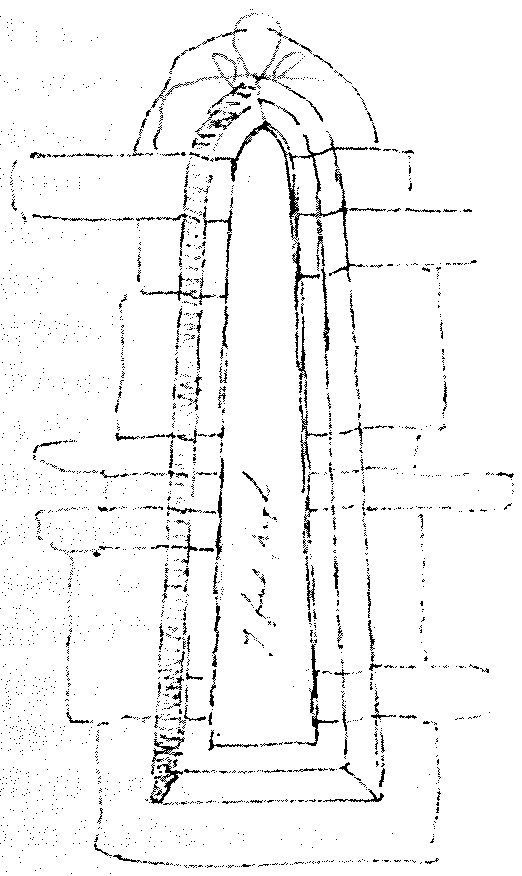
The other windows are similar, except that some of them have semicircular heads.
Now from meeting windows of this class in buildings otherwise distinguished for the peculiarities of what you properly enough call the Primitive Irish style, as well as in churches in which such peculiarities do not occur, I come to the conclusion that they do not indicate a different age. As an example of
incorporation of the two styles, I was about to sketch you the East window of the church in church island in Lough-Key of which I already gave you an outline of the doorway p. -, but I find it so exactly agreeing with this window of Temple Brecan that the sketch of the one will do for the other, the only difference being in their size, the one 7 feet high, the other 6 feet. But in fact I could give you a score or more such examples from my memorandum books.
And here let me point your attention to a peculiarity in all these examples of which I have been just now treating and of which you will see an illustration in the sketch on the preceding page, namely that the stones are not laid in regular horizontal courses but are sometimes horizontal and sometimes perpendicular. This characteristic feature in ancient architecture was first noticed by Mr. Rickman the best architectural antiquary now in England, and it is his opinion that (it) is found in no building in England except those of the earliest Saxon times. He gives it the name of "long and short masonry". That it
is in Ireland also a certain characteristic of buildings of the earliest age, I have now not a shadow of doubt, but I also hold that its absence is no proof, in itself, that buildings are not of equal antiquity, and this is proved by the fact that many of our churches in the old Pelasgic style do not present examples of it, and it is therefore most probably of Roman origin. I would recommend you to attend to this peculiarity in your future examination of ancient buildings, and to note its presence or absence. And that you may understand it clearly I make a sketch at the side, as found in the angle of one of the churches at Monasterboice.
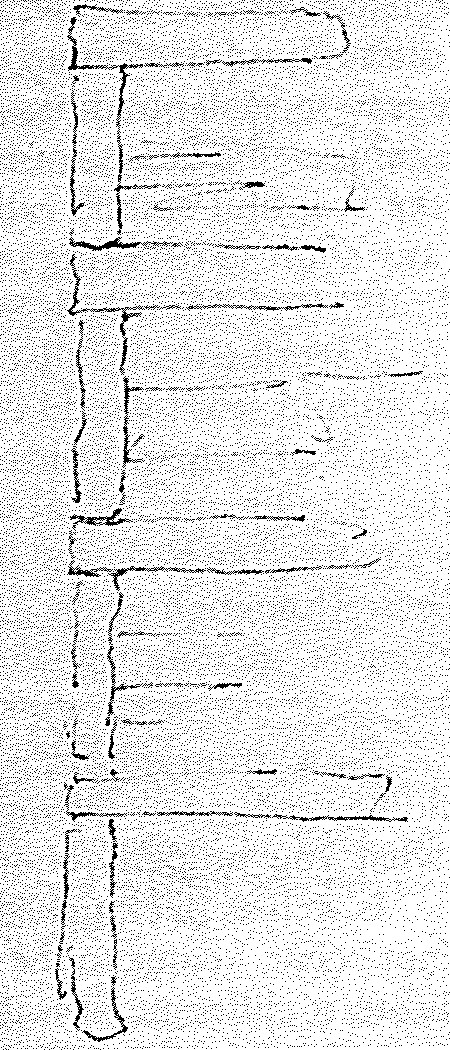
I return to the pointed arch. Hitherto I have only spoken of its ancient occurrence in windows, but I have met with one instance at least of it in a choir-arch, which I could not help believing of the earliest christian age, namely in the church of St. Kevin or Caomhan, in one of the Arran isles, which is undoubtedly of the 6th century and which all the other parts ([Probably in the hand of J. O'Donovan:] no!) of the building are in
the Pelasgic, or primitive Irish style. (View it again; you were but a young antiquary at the time. There is a pointed doorway in the south wall of the same age, J.O'D.) I do not however, recollect to have ever met with a pointed arch, or gothic doorway in the West end of a church, and I confess that I always look with suspicion of the great antiquity of a church in which I find such a doorway in the South wall, except when this doorway is obviously, from the character of its masonry &c, a later work, as it often is. I greatly doubt however, your conclusion that pointed-arched doorways do not occur of a date anterior to 1126. The oldest churches apparently on Scattery island have pointed doorways, and indeed I just recollect that the churches on Inis caltra also have pointed doorways which are in the West wall and are unquestionably the original ones, but these cannot be earlier than the 7th century. If you are right in your conclusion as to the age of pointed arch doorways it would prove that one at least of our round towers was erected in or after the 12th century. Thus, one of the Towers at Glandalough was erected against the West wall, and was entered by the original doorway of the church which is in the Pelasgic style. It was ne-
cessary therefore to make a new doorway to enter the church, and this was made in the South wall and in the pointed style. Ergo, either this doorway was anterior to 1126 or the Tower posterior. [In left-hand margin: The tower is posterior I maintain, and why not? JO'D]
On your "characteristics of the Parish churches erected in Ireland from the year 1180 to the period of the Reformation", I have little to say, as if my conclusions on your former conclusions be at all correct, these[?] also must be wrong to a considerable extent. I will however remark that your assertion that the doorways after the year 1180 are never placed in the West end, supports my view of the antiquity of the churches on Inis cealtra, as well as of the antiquity of the pointed arch, which occurs in doorways there on the West end. And hence too I think you are not borne out fully in your assertion that the church of Kilcloony cannot be older than the 12th century. [In left-hand margin: It is not near so old as the 12th century JO'D]
And now a few words now in conclusion. I have written this letter very hastily, though it
has been a long time in hands, because I only turned to it when I had nothing of more pressing importance on hands. I have indeed only glanced at the subject, and this for the purpose of leading you and your coadjutors, who I find have adopted your opinions as laws, to look more accurately about you, and thus arrive at the truth which we both - indeed all - desire to find.
You know that I can bear well being shown to be in error, and indeed, in this case, I should be delighted that such were the result, as it would remove many difficulties which puzzle me, and reduce everything to certainty. Theories should be adopted very slowly and not until every difficulty was disposed of. If we take a different course, adopting the theories & making the difficulties which stand in the way bend to our conclusions, we deceive ourselves, and lead others into error. It has long struck me that O'Conor has been often doing this, and yourself sometimes, and this has been my chief object in writing,
to put you more on your guard. It is no matter which of us is in error - the collision of opinion will lead to truth - and recollect I do not put my opinion dogmatically, but rather as doubts which I wish to have removed.
my dear John,
faithfully yours,
George Petrie.
J. O'Donovan, Esq.
